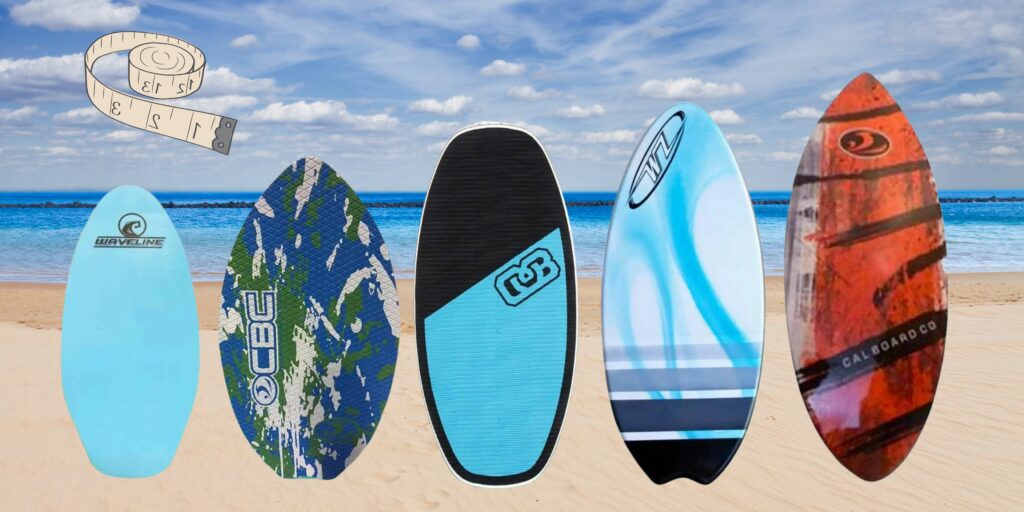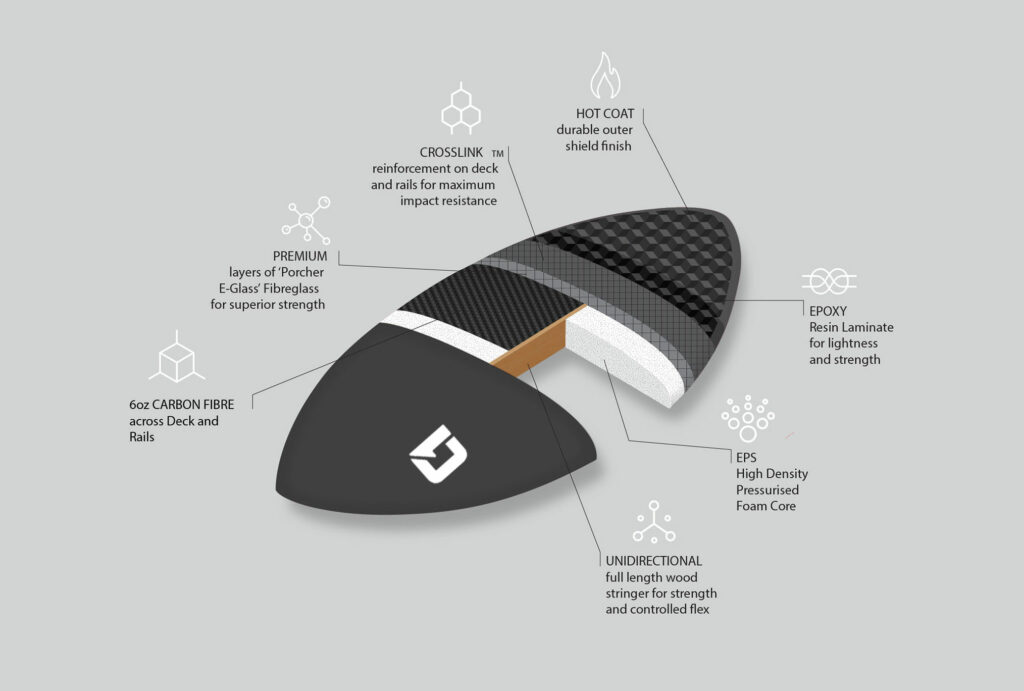When it comes to skimboarding, not all boards are created equal. The type of skimboard you choose plays a critical role in performance and safety. From materials and construction to rocker, size, and shape, small design factors make a big impact on how a board handles for riders of different skill levels.
Overview of Different Skimboard Types
This article will break down the key differences between types of skimboards. We’ll look at the four main materials used: foam, wood, fiberglass, and carbon fiber. How durable, rigid, heavy, and expensive each option is varies widely. Shape and size considerations like length, width, thickness, tail design, and rocker profile also affect suitability for flat water tricks versus waves. Finally, we’ll provide specific guidance on ideal boards for beginners, intermediate, and advanced riders.
Understanding these key variances will empower you to pick the perfect skimboard for your abilities. Matching your height, weight, local wave types, and skill progression to the right design will translate to better control, faster learning, and more enjoyment on the water. With the foundation covered here, choices become clearer. Now let’s explore exactly what separates a basic foam board from an expert carbon fiber shred sled!
When browsing the racks of colorful skimboards, they may seem quite similar in shape and structure at first glance. But several key differences in materials and construction set them apart drastically in terms of cost, durability, performance, and learning curves for riders. We can break skimboards down into four main categories – foam boards, wooden boards, fiberglass boards, and carbon fiber boards.
Different materials used in skimboard construction:
Foam Skimboards
- The most basic and affordable option for beginners, featuring an EPS foam core covered in one or multiple protective fiberglass layers.
- Soft and buoyant, making it easy to progress basic riding techniques on flat water or small shorebreak.
- However, the flexible decks lack the rigidity needed for more responsive turning as skills develop.
Wood Skimboards
- Traditionally made wood boards offer the iconic skim style many visualize.
- Hardwoods like maple or okoume provide excellent strength and snap, ideal for ollies off waves and flat water tricks.
- Solid wood construction comes at a weight penalty, lacking the lightness needed for bigger airs. Better suits intermediate to advanced riders.
Fiberglass Skimboards
- Fiberglass cloth reinforced skimboards represent a middle ground, balancing cost, durability, and performance.
- The fiberglass layer adds substantial rigidity and impact resistance compared to basic foam builds, making them a common choice as riders progress past the beginner phase.
Carbon Fiber Skimboards
- The pinnacle of high-performance equipment, carbon fiber boards offer elite stiffness and strength combined with ultralight weight.
- Full carbon skimboards cost well over $1000, putting them out of reach for casual hobbyists. The outstanding responsiveness ensures only experts with precise board control can unlock their full potential.
Comparison of foam, wood, fiberglass, and carbon fiber Skimboards:
When it comes to choosing a skimboard, the core construction material is the most important decision as it affects cost, durability, weight, and performance.
Cost:
- Foam boards start around $100
- Fiberglass boards run $200 – $500
- Wood boards are $300 – $800
- Carbon fiber boards cost $1000+
Durability:
- Foam dents easily and lacks impact resistance
- Fiberglass and carbon resist dings well
- Wood is prone to chips but can be repaired
Flexibility:
- Foam has high flex but this hampers control
- Fiberglass has moderate flex for a responsive feel
- Wood and carbon offer the most rigid ride
Weight:
- Foam and fiberglass boards range from light to moderate weight
- Wood adds significant heft
- Carbon provides very low weight
Performance:
- Foam allows beginners to learn but limits trick potential
- Fiberglass strikes a good balance for intermediate riders
- Wood offers high-end control but the extra weight hinders airs
- Carbon provides elite response for experts to push limits
As you can see, core construction plays perhaps the biggest role in determining a skimboard’s overall quality and capabilities on water. Test riding different materials helps inform what combo of affordability, robustness, and high-performance best matches your abilities today – and your progression goals for tomorrow.
Different Shapes & sizes of Skimboards:
Beyond construction, the shape and dimensions of a skimboard also greatly influence its handling and performance. For all skill levels, proper sizing relative to the rider’s height and weight enables better control and speed. Tail shapes and rocker profiles also impact turning agility and wave riding prowess significantly.
Explanation of Tail Shapes and Rocker in Skimboards:
Skimboards typically have one of three tail shapes:
Pin Tail:
- Features a rounded, gradually tapering back end.
- Allows smooth carving turns and stability.
Dual Pin Tail:
- Has two sharp corners that form the tail.
- Generates speed off waves but harder for beginners to control.
Square Tail:
- Straight, flat back profile.
- Prevents backwash on wave entry for beginners learning board positioning.
Rocker:
- Refers to the vertical curve shape along the board from tip to tail.
- More rockered boards have higher curvature to better navigate waves.
- Flatter rocker provides stability for new riders.
How Tail and Rocker Affect Performance:
- More curved pin tails let you hook tight turns on waves.
- Square tails assist first learning proper stance.
- Higher rocker handles waves with agility but provides less flat water speed.
Considerations Based on Skill Level:
- Beginners should focus on longboards with square tails and flat to mild rocker until mastering positioning and stance.
- Intermediate riders can attempt more curved pin shapes with moderate rocker to develop smooth turns.
- Advanced wave hunters utilize the highest rocker profiles and sharply curved dual pin tails for attacking steep peaks.
Conclusion:
When it comes to skimboarding, the equipment makes all the difference between frustratedly falling and effortlessly gliding across the shallows. By now, the key differences between foam, wood, fiberglass, and carbon fiber constructions should be clear when it comes to cost, durability, and performance tradeoffs. Getting the right features to complement your riding style, skill level, and local shore break or tidal flats is equally important.
Matching your height and weight to the appropriate size board ensures better control and speed potential. Considering rocker profiles and tailored tail shapes for wave riding vs. flatland tricks enables each ride to be more successful. While advanced riders enjoy the high-performance benefits of carbon fiber, beginners progress quicker on forgiving foam builds.
Ultimately the perfect skimboard combines ideal construction, shapes, and dimensions to balance affordability with progression potential. Now that you understand these variances hiding beneath the fiberglass, you can unlock that perfect ride matching your abilities today and aspirations for tomorrow. Just don’t forget the sunscreen before you charge forth on your next epic slide across the glassy shallows!
I am Fornillos Bogs, a seasoned professional surfer and accomplished skimboarder originally from Tanauan, Leyte, Philippines. With a remarkable background in both sports, I have carved my niche in the aquatic world. Currently, I reside in Quezon City, Philippines, known for my exceptional skills on the waves and impressive performances in skimboarding competitions. My journey from the serene shores of Tanauan to the bustling city of Quezon City serves as an inspiring testament to my dedication and passion for riding the waves.


